Amateurs at the Heart of Noh: The Challenges of a New Era
Diego Pellecchia
Post-doctoral researcher at the ARC Art Research Centre, Ritsumeikan University
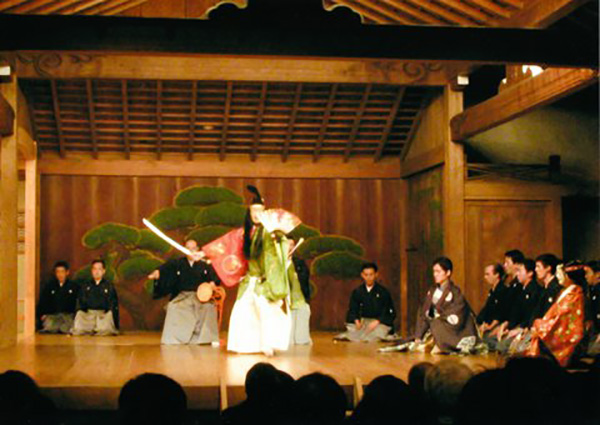
Noh: Kiyotsune Kongoh Noh Theatre, Kyoto
Photo: Suzuki Kazuma
With the advent of the Meiji restoration at the middle of the nineteenth century, the feudal system that ruled Japan for over 250 years ceased to exist. The professional Noh theatre troupes that benefitted from the official support of the aristocracy suddenly found themselves without institutional and economic backup. After an initial critical period, Noh was re-established as official performing art and started to receive a limited amount of funding from the institutions. Despite formal backing, the many expenses Noh performers needed to face in order to recover from the crisis required a more consistent as well as regular source of income. While in other performing arts performances are repeated over numerous weeks or months, in Noh a performance is only staged once. Although some actors are employed in various roles (minor roles, chorus, stage assistant) over different productions, their fees are not enough to cover their living expenses. In response to this situation, performers resorted to teaching amateurs, mostly members of the new middle class. Since then, the economics of the various stylistic schools of Noh have been based on this system, creating a strong link of mutual dependence between amateurs with professionals. However, with the burst of the economic bubble in the late 1980s, the amateur population has started to shrink. As a consequence, the economic conditions of the Noh establishment have become unstable, posing a serious threat on the future of the new generations of professionals. In order to better understand this situation, and to sketch trajectories of solution, it is important to take a closer look at the role of amateur practitioners in the Noh world.
Two groups that support the Noh world: university students and regular amateurs
It is possible to roughly divide Noh amateurs in two groups: university students who belong to Noh clubs, and 'regular' amateurs who practice directly at the okeikoba training space of a professional performer. University students join clubs for the duration of their curricula, usually three or four years. During this period they train intensively with fellow students and with one or more coaches, often 'O.B.s', ex-members of the same club who have become semi-professionals after graduation. A fully professional actor supervises the club activities and delivers a limited number of lessons each month. Students are also involved in recitals, generally once or twice a year, depending on the size of the group. However, after graduation the majority of the students cannot continue training as regular amateurs: some of them have attended universities in Osaka, Kyoto or Tokyo, but go back to their hometowns to look for employment. In many cases, jobs with demanding timetables and, later, family commitments are an obstacle to those who would like to go back to training, but choose to dedicate time and money to their own families instead.
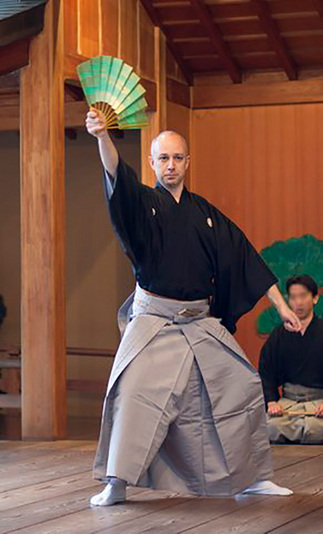
Shimai: Yashima Yamatoya Noh stage, Matsuyama
Photo: Fabio Massimo Fioravanti
Large expenses which come upon regular amateurs
While students benefit from large discounts (in some cases club fees are paid in full by the universities), regular amateurs face large expenses. In addition to ogessha, the monthly fee paid to the teacher, amateurs are encouraged to purchase tickets to performances by their teachers, and to subscribe to the regular programme of the school they belong to. Unlike other theatre forms, Noh is self-funded: in most cases professional actors are also the executive producers of their own shows. Therefore, they need to make sure that tickets are sold and that the hall is filled. Amateurs play a crucial role in this: studying with a professional means becoming affiliated with a particular group, which implies supporting performances by buying and selling tickets on behalf of the teacher. In fact, a large part of the current Noh spectatorship is composed of amateurs of various degrees of expertise.
Regular amateurs are involved in recitals, too. However, in order to perform they need to provide for the rental of stage, costumes, masks, pay for the other performers, and purchase a menjō, an official permission required in order to be allowed to perform a certain piece. Such licenses are granted by, and paid to the iemoto, or head of the school to which actors belong. Altogether, these expenditures can reach rather high figures, contributing to the reasons why many university club members give up practice after graduating.
A pressing issue: the decrease in the number of Noh professionals
The current Noh 'regular' amateur population is largely composed of retirees, individuals without children, or housewives. These amateur groups are ageing, and so are audiences. University Noh clubs constituted an important source of recruitment of future professionals, yet the unstable and shrinking market does not encourage the new generations to try this path. Today many 'professional' actors need to rely on side-jobs in order to keep up with their life expenses, a condition that problematizes the actual significance of the word 'professional'. Reduced financial capability of performers means fewer chances for them to go on stage in privately funded events. In sum, to the decrease in the number of amateurs corresponds not only a reduction of the audience, but also a reduction of the number of Noh professionals, a particularly tangible issue in small schools where the continuation of tradition will depend on the capacity of the professionals to attract new amateurs, that is, a new audience.
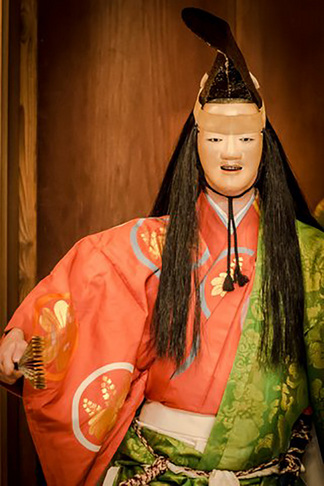
The author on stage, playing a shite main role for the first time
Noh: Kiyotsune Kongoh Noh Theatre, Kyoto
Photo: Stéphane Barbery
Targeting potential audience or maintaining the existent audience
The way Noh is marketed in Japan is not sufficiently appealing to the young generations: Noh is often advertised by emphasising its historical importance rather than its contemporary relevance, with an emphasis in maintaining the existent audience instead of trying to reach new 'catchment areas'. Moreover, Noh suffers from a lack of young and charismatic stars like Kabuki actors Ichikawa Ebizō or Ennosuke, mostly because its representatives are chosen according to seniority and lineage, rather than popularity.
Though experiments featuring Noh actors and artists from different backgrounds are now frequent, they often result in a superficial superimposition of different techniques rather than in an effort to merge different practices. This is partly due to the isolation from other arts: busy training and teaching for living, little time is left for individual research and experimentation. Many professional actors have tried to write new Noh, or shinsaku-noh, though many of them possess little knowledge of techniques outside their area of proficiency, hence even newly written plays tend to follow classical aesthetics. In addition the Nōgaku kyōkai, the Noh Professionals Association managing the activities of all professionals, often endorses a conservative line, sanctioning those who depart from orthodoxy, hence not encouraging actors to follow the path of innovation.
The strictness and sectarianism of Noh has allowed performers to reach high levels of formal perfection, and this has brought to the formulation of an extremely refined aesthetic language, though one that only a few can speak. Most of these few are in fact the amateurs who dedicate time and money to learn a language they will never fully master, and that is little understood outside of the premises of Noh. Training in the Noh world implies submission to a tradition embodied by the teacher, who is in turn dependent to the iemoto, supreme leader of each stylistic school. For the amateurs, the output of their process of artistic acquisition, the recital, is a reproduction of a shape they have learnt, not a creative act. As a consequence of their condition of dependence, amateurs always need to refer to their teacher in order to perform. It should not surprise that the young interested in the performing arts as forms of artistic expression are more likely to get involved in other forms where creativity and individuality is valued over respect of the laws of tradition.
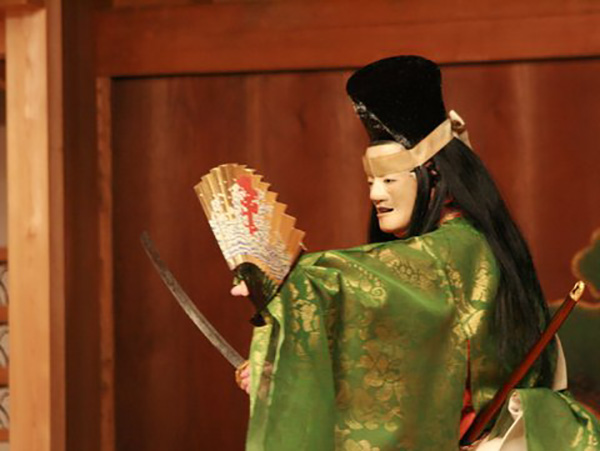
Noh: Kiyotsune Kongoh Noh Theatre, Kyoto
Photo: Barbara Mosconi
Facing shortage of 'amateurs'
Today, the symbiotic relationship between Noh and amateurs appears to be in need of nourishment: actors perform for the same spectators, many of whom are amateurs. In turn, amateurs support their teachers buying tickets and going to performances. Noh is undergoing a phase of stagnation, with little turnover both from the side of the producers and from the side of the consumers. In order to survive, Noh actors need to target a new kind of audience, as well as new amateurs: Noh can no longer rely on the support of those who began practising in the 1970s or 1980s.
Foreigners or non-Japanese amateurs as the key to exit the stagnation
The issue at stake here is not only the number of amateurs, but the kind of amateurs: one of the few exceptions to this condition are foreigners who study Noh, whose reception is not marred by the image of Noh as a conservative or old-fashioned art. In fact, unlike most Japanese amateurs, many of the non-Japanese who take an interest in Noh come from a theatre and performance background, and are attracted by the practice of Noh in itself, rather than its cultural value as high-class status symbol. Many of these amateurs are interested in learning Noh and then use it in a creative way in the creation of other art. However, as most foreigners come to Japan in order to study Noh only for a limited period of time, their access to knowledge is limited, and, as in the case of Noh actors with little proficiency outside their sphere of competence, much of their creative effort results in poor or superficial imitation. If diversification and opening of Noh is the key to exit this stagnation, it is necessary to consider ways for foreigners to study Noh more consistently, and on a longer timeframe. This could happen in Japan or even abroad, if Noh professional were able to work and study overseas for longer periods.
Osanai Kaoru (1881-1928), one of the key figures in the development of Japanese modern theatre, believed it was necessary to 'turn professional actors into amateurs' in order to create new theatre. What Osanai was looking for were professional Kabuki actors who could be free from the dominant traditional institutions, hence be flexible enough to serve in his modern productions. [1] In Noh, as in Kabuki, freedom and creativity are necessary elements for the art to develop in the contemporary world. The amateur is not one who knows less, but one who is capable to communicate both with the inside and the outside of Noh. Therefore, the new amateur should be not a foot soldier, but an ambassador of Noh.
1. See Morinaga, Maki Isaka. 'Osanai Kaoru's Dilemma, "Amateurism by Professionals" in Modern Japanese Theatre'. TDR, 49.1 (2005), p. 119-133.
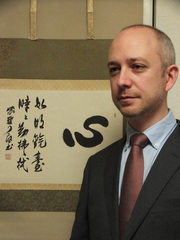 Diego Pellecchia
Diego Pellecchia
Diego Pellecchia received his PhD in drama & theatre studies from Royal Holloway, University of London with a thesis on the reception of Noh theatre in the West. He currently is a Japan Foundation post-doctoral fellow at the ARC Art Research Centre, Ritsumeikan University, Kyoto, where he is conducting a research on the role of amateurs in the world of Noh. Pellecchia studies Noh under Master Actor Udaka Michishige (Kongō School): in 2013 he took his first shite main role in the Noh Kiyotsune at the Kongō theatre in Kyoto.
Photo: Kim Hea-Kyoung
Back Issues
- 2019.8. 6 Unraveling the Maker…
- 2018.8.30 Japanese Photography…
- 2017.6.19 Speaking of Soseki 1…
- 2017.4.12 Singing the Twilight…
- 2016.11. 1 Poetry? In Postwar J…
- 2016.7.29 The New Generation o…
- 2016.4.14 Pondering "Revitaliz…
- 2016.1.25 The Style of East As…
- 2015.9.30 Anime as (Particular…
- 2015.9. 1 The Return of a Chin…

